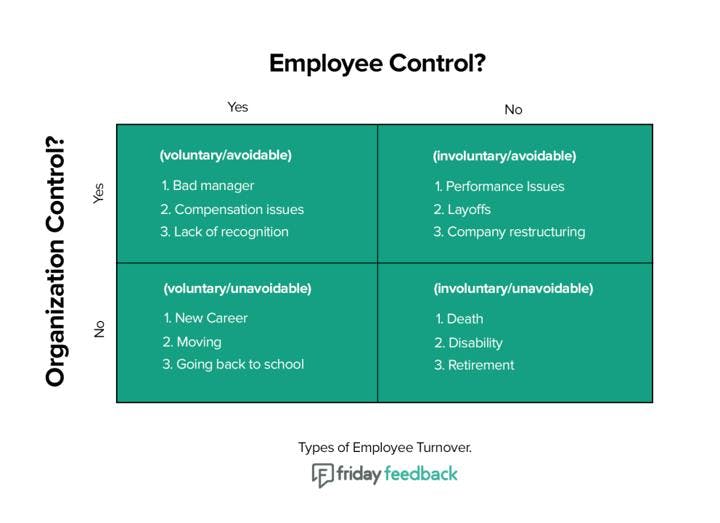How to calculate employee turnover

If you’re a leader inside an organization who wants to gain market share, grow revenue, and gain a leg up over the competition, you need to retain your best employees. An unfortunate truth is that in many organizations, they have no idea what the employee turnover rate is – or if they’re measuring it, it’s far too simplistic.
In this guide, we’re going to cover the various facets of employee turnover, how to measure it, and how to establish benchmarks to see if you’re on the right track. This a key piece of continuous improvement as an organization.
Who is responsible?
In the past, this data is measured by HR leaders. We’re experiencing a shift in the landscape where the best organizations understand that improving turnover and engagement is a company-wide effort. Put simply, if you care about improving turnover, it needs to be something that every manager understands and measures inside their departments.
Employee Turnover Equation
The first place many leaders start is by calculating the employee turnover rate in aggregate. This is a basic calculation; start by taking the number of employees who left the organization, and divide it by the time period. The result is expressed in a percentage. The formula is below:
(number of employees who leave) / (average number of employees during time_period)
Let’s use an example. If you have one hundred employees, and ten employees leave over the course of the year, your turnover rate is 10% (10 employees left) / (100 employees).
We recommend that you measure turnover quarterly or yearly, but not monthly. The reason why is because it’s common for employees to leave at the end of the month. This can throw off your turnover numbers because you’ve zoomed in too far. While we applaud you for caring enough to measure turnover in aggregate, you need to go a step further and segment turnover so it’s more actionable.
Voluntary vs. Involuntary Turnover
Calculating turnover in aggregate is only the beginning – it’s time to segment to gain a better understanding of what’s going on. For example, what if an employee is fired? What if an employee leaves on their own free will for a new opportunity?
Surely these two situations must be tracked differently. This is why you need to track voluntary turnover vs. involuntary turnover. These are defined below:
- Voluntary turnover – turnover that is initiated by the employee (i.e. – the employee “volunteers” to leave the organization)
- Involuntary turnover – turnover that is initiated by the organization (i.e. – the employee doesn’t “voluntary” to leave)
Can you see how segmenting based on the above criteria is valuable? After all, the purpose of measurement is to better understand how to improve.
Avoidable vs. Unavoidable Turnover
Now let’s segment even further by measuring avoidable turnover vs. unavoidable turnover. What’s the difference?
Avoidable turnover is when an employee leaves and it’s something you as an organization could have prevented. The exit could have been avoided. The issue is in your control, it’s not an issue with the employee and their performance.
Unavoidable turnover is the turnover that you have no control over. For example, if you require employees to be present in the office, and one of your employees is moving to take care of an aging parent.
Mapping Employee Turnover
Now let’s blend these examples together. We’ve created a handy graph below to illustrate the various types of turnover.

Dysfunctional Turnover
While the above visualization is helpful to understand the various definitions of employee turnover, it can also be a bit confusing to remember and codify what each type means. After all, the goal of measuring turnover is to identify where your organization needs to improve if you’re stuck trying to remember the various definitions, that’s not helpful.
The truth of employee turnover is that it can be outside your control (for example someone decides they’d like to change careers or move to another state). Is that something you should measure? Sure. Does it inspire action? No – because you can’t change it.
Let’s focus on what we can control. How do we do that? By measuring dysfunctional turnover.
Dysfunctional turnover is when your best employees leave.
The first step in this process is to identify and bucket top talent. The most logical way to do this is by reviewing individuals who have high marks in a recent performance review. To calculate dysfunctional turnover, use the updated formula below:
(top talent who leave) / (average number of employees during time period)
If you’re looking to reduce dysfunctional turnover, focus on recognition and empowering managers (especially new managers).
Make sure you dig deeper
Now that you understand the formula for dysfunctional turnover, it’s time to start digging into why key employees leave.
It’s common for an organization to start segmenting employee turnover by gender, age, geography, and other attributes. They start by looking at the data. This can be helpful inside a larger organization, but we recommend that you dig deeper and try to understand the root cause first. This same notion applies when measuring employee engagement.
We recommend data analysis, but not as the first step. Why? The process of analyzing data is guided by assumptions. In order to find a direction, you need to dig deeper and collect the richest feedback possible. This can’t be accomplished by looking at data points. You need to go directly to the source.
When this has been completed, it’s okay to zoom out and segment by organizational data.
A note about tenure
One final note is that it can be helpful to segment turnover by tenure. The primary goal of this is to understand the stage of the employee lifecycle that might have an influence. In other words, if an employee churns in the first three months, it’s most likely an onboarding problem. If they leave after a few years, you may need to institute learning and development programs.
Now that you’ve segmented turnover, let's dive into benchmarking turnover so you know you’re on the right track.
How to benchmark employee turnover?
Benchmarking employee turnover can be a healthy exercise to understand how you rank against others, but we believe this exercise is of limited use. Each organization is different and faces its own set of challenges. It’s better to focus on a known number (past dysfunctional turnover) and improve it instead of spending your time worrying about a competitor. It’s also possible they are measuring turnover differently.
Think of improving turnover like a runner might think about a race. They may not be the fastest on the field, but as long as they continually improve against the past, important progress is being made.
With that being said, there are a few ways to benchmark turnover.
Economic Climate
As you might imagine, voluntary employee turnover is higher when people know they can find another job. As such, the economic climate has a major influence on turnover. If the economy is doing poorly, it’s likely that turnover will be lower than normal. With that being said, employees may stay, but employee disengagement will be high.
External Data Sources
Many organizations will purchase reports that break down employee turnover by region or locality. We’ve done research and have yet to find a reputable resource that we recommend in this regard. Keep in mind the data from organizations is self-reported, so it’s possible that the data has a high degree of variance.
Ask others in the industry
Our best piece of advice when benchmarking turnover is to ask others in a local networking group. For example, if you work in HR, ask other practitioners what they’ve seen. You can also talk to an HR consultant, as oftentimes they have worked with many organizations and can identify patterns in the local market.
In conclusion
To wrap up, if you don’t calculate employee turnover, it’s highly unlikely that you will you improve it. Take the time to correctly track employee turnover, especially dysfunctional turnover. If someone puts in their notice, take the extra time to dig deeper into the root cause for leaving. Consider having teams setup regular check-ins and 1-1 meetings to help.

